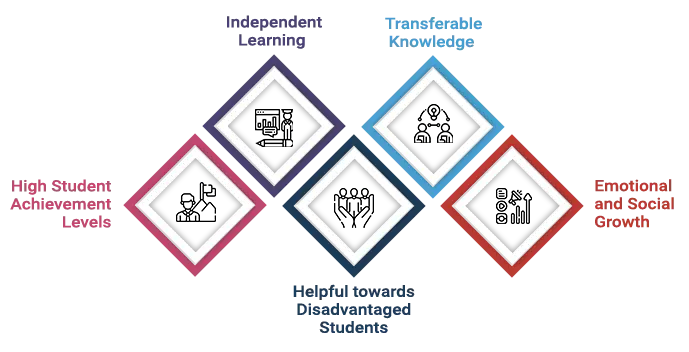Good scores on the report card, being active in classroom activities, and responding enthusiastically to teachers' questions are typical signs of attentive and ‘’good’’ students. On the other hand, struggling to pass tests, failing to focus and keeping up with the rest of the class is a clear indication of ‘’bad students’’; that is what the common perception is in this regard.
Categorising students depending on their academic performance is the norm, but we seldom take the initiative to understand individual shortcomings. Furthermore, when the education system is conducive to following the same old methods, it is detrimental to student learning. Therefore, we need pedagogies that incorporate metacognition, enabling teachers to elevate the teaching and learning mechanisms.
What is Metacognition?
Metacognition means an individual’s ability to plan, assess, monitor and make the required changes to one’s learning habits, enabling them to deal with challenges constructively. Although a simple definition points it to be ‘’ thinking about thinking,’’ it goes far beyond that; it relates to active monitoring and enhancing the thought processes.
Moreover, the metacognition process establishes self-regulation, self-awareness, critical thinking and analytical skills, helping individuals solve problems with unique solutions. In the context of education, when students go through the process, they gain skills that help them recognise their cognitive abilities. As a result, they can self-direct their learning, gauge their progress, and identify the areas they struggle with the most and their primary causes.
Besides, metacognition skills improve their basic cognitive processes like memory, attention, activation of prior knowledge and the aptitude to complete a given task. Consequently, it makes them better learners as they can learn, retain and implement information effectively.
Benefits of Developing Metacognitive Skills in Students

1. High Student Achievement Levels
Teachers bear the primary responsibility of optimising learning habits; hence, they must introduce strategic plans of action step by step. For instance, employing metacognition strategies such as learning and thinking journals should be prioritised. So, teachers can encourage students to keep a journal wherein they can highlight crucial questions on a weekly basis, reflecting on their learning journey such as:
- What was the most difficult part of the lesson?
- Is my present study habit and schedule conducive to attaining learning goals?
- What are the recurrent doubts that keep coming to my mind?
- What strategy would be appropriate to help me overcome my shortcomings?
The biggest advantage of maintaining a learning or thinking journal is that students would be able to identify their central issues. Concurrently, it will improve their self-awareness and look for ways to solve those issues; they can independently work on relevant solutions or take the help of the teacher.
As a result of metacognition learning, they become self-motivated and develop improved learning habits, helping them achieve academic goals. In fact, research has highlighted the fact that the combination of timely guidance and accurate methodology serve to reduce cognitive limitations.
2. Independent Learning
Teachers dictating or providing elaborate instructions and students taking notes has been a common practice for as long as one can remember. Although the method has merit, it is a passive learning mechanism that leaves little to no room for student participation. Hence, there has been a shift to a new approach wherein learners take an active role in the classroom.
Notably, a teacher plays an integral role of a facilitator or a moderator, and the student must take a more independent role. For instance, for a group project or assignment, students can discuss in detail and lay out the plan. So, each member is responsible for completing a specific task, and by the end of the deadline, they will present the project together.
This is a great example of independent learning, which is a core component of metacognition theory; learners get the chance to self-evaluate and analyse facts and develop a piece of work indicating their individuality. Hence, in the long run, they gain the ability to make independent decisions based on accurate research and discovery, which can be applied beyond the classroom.
3. Helpful towards Disadvantaged Students
Who are disadvantaged students? Students who struggle academically and are unable to match the pre-established standards of excellence. However, when most students do their best and don’t fall short in their attempts, why do some fail to do the same? The answer is plain and simple; every pupil’s comprehension or knowledge levels are not the same, and neither are their personalities.
Therefore, instead of forcing everyone to be the same, metacognition teaching strategies strive to support all students, irrespective of their aptitude. So, the students who are at a disadvantage compared to their peers can determine their weaknesses and participate in the process to improve their performance.
Besides, when teachers utilise suitable metacognition examples within the classroom with the help of tools such as KWL charts, it helps students organise their learning. The chart is an organiser that enables students to streamline information before, during and after a unit or a lesson. The letters KWL stands for ‘’know, want and learn; each word signifies an individual component; their prior knowledge, things they want to know and things they learned.
4. Transferable Knowledge
One can call education purposeful only when it incorporates subject knowledge and upskilling together to prepare students to face difficulties in the future. Hence, a curriculum that includes methodologies to enhance student’s skills and capabilities is the need of the hour. And that is where metacognition in education becomes the most useful strategy to help students become aware of their progress.
Furthermore, metacognition helps learners transfer their knowledge and understanding across different contexts and activities. For example, they can implement it in reading, comprehension, writing, mathematics, analysis, memorising, reasoning and problem-solving. Also, they will complete any given task with the help of the skill and self-evaluate it further to ensure its accuracy.
5. Emotional and Social Growth
When students gain clarity over their thought processes, it becomes easy for them to do the needful to make a precise decision. Moreover, they open up to new perspectives and feel the need to listen to others’ points of view even when they disagree with them. So, gradual emotional and social growth is a beneficial attribute of metacognition regulation, which helps them become well-adjusted individuals.
In Conclusion
The outdated and regressive habit of rote learning and memorisation leads to ineffective educational goals. On the contrary, teaching cognitive skills can help students learn significant ways to process and retain information clearly. Also, they will be able to self-evaluate and monitor their progress and identify crucial ways to improve their learning.
 Author:
Author:
Prashant Borkar,
Academic Consultant